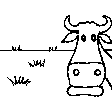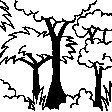



This technology is used during the dry seasons and where ground water level is high and there is natural water stream flowing from underground water source. Water pond is excavated along the naturally flowing water stream and is recharged by natural ground water. The size of the pond will vary depending on the area available, groundwater table, slope and soil characteristic. Groundwater collection ponds described in this technology on average are 4m long, 3m wide and 1m deep of 12m3 (12 000 liter) capacity and the slope is moderate 5% to 8% and soil characteristics is clay loam with deep soil. Water troughs (Elyato by local name) are constructed adjacent to the water pond to allow livestock to access clean drinking water. The number of troughs per pond is usually 1 to 2. Materials used in construction of water trough include clay, red termite mound soil, grass and wooden poles. The number of ponds needed usually depends on the expected number of animals and are arranged at irregular intervals ranging from 10 to 20 meters apart. The average size of a water trough is 0.14 m3 and can cater for 5 cattle at a time. The Pond is stabilized by naturally growing grass on its banks. Common pond stabilizer species are Leodicatiar digitalia and Hyperrhenia rufa. Management of the natural water source is through preventive village/customary by-laws which prohibit tree and grass cutting around the water source. The dominant indicator tree species normally found are Erythrina abysinica, Ficus thorgii and Phoenix recrinata. The animal watering troughs are usually used in the dry period. Before watering the troughs are coated (smeared) with red termite mound soil (normally hand carried by herders) to provide a good taste which is attractive to animals. Water is transferred from the pond to the water trough manually using cans or buckets. Animals drink directly from the troughs. This water from the trough is rich in iron (Fe) from red termite mound soil. The troughs are constructed with outlets used to spill out water immediately after drinking in order to prevent their damage through excessive water saturation.
Purpose of the Technology: This technology is preferred by livestock keepers as it provides for animals to drink clean and mineralized water and for health improvement. User fee payed to land owners also enable them to expand and diversify there income sources.
Establishment / maintenance activities and inputs: Establishment: Land clearing, excavation and shaping of water pond and construction of animal watering trough.
Maintenance: repair of water pond and water trough (de-siltation, grass slashing and gap refilling).
Inputs: labour, implements (machete, spade, hand hoe, sickle), clay, red termite mound soil, wooden poles, buckets, grass and tying rope. Average establishment cost for one pond and its water trough is 41.27 American dollars. Average annual maintenance and recurrent costs (filling and emptying of water trough) for one pond and its water trough stands at 458.76 dollars and labour is a core cost determinant factor.
Natural / human environment: Natural environment: Extensive grazing land. The technology is largely structural (excavation and shaping of water ponds and construction of water troughs) supported by the use of by-laws which prohibit destruction of the protective natural and indicative trees and grasses around. The technology is common in sub-humid climatic zone.
Social economic environment: Level of mechanization is handy tools with subsistence production systems on individual fields.

Location: Missenyi District (Minziro), Tanzania, Tanzania, United Republic of
No. of Technology sites analysed:
Spread of the Technology: evenly spread over an area (approx. < 0.1 km2 (10 ha))
In a permanently protected area?:
Date of implementation: more than 50 years ago (traditional)
Type of introduction











| Specify input | Unit | Quantity | Costs per Unit (Tanzanian shillings) | Total costs per input (Tanzanian shillings) | % of costs borne by land users |
| Labour | |||||
| Land preparation for pond excavation | person/day | 1.0 | 1.25 | 1.25 | 100.0 |
| Construction of pond | person/day | 1.0 | 21.88 | 21.88 | 100.0 |
| Construction of water trough | person/day | 1.0 | 3.13 | 3.13 | 100.0 |
| Equipment | |||||
| Tools | piece | 1.0 | 3.13 | 3.13 | 100.0 |
| Tools | piece | 3.0 | 9.38 | 28.14 | 100.0 |
| Construction material | |||||
| Wood | pieces | 2.0 | 1.25 | 2.5 | 100.0 |
| Earth | kg | 20.0 | 1.25 | 25.0 | 100.0 |
| Total costs for establishment of the Technology | 85.03 | ||||
| Total costs for establishment of the Technology in USD | 0.05 | ||||
| Specify input | Unit | Quantity | Costs per Unit (Tanzanian shillings) | Total costs per input (Tanzanian shillings) | % of costs borne by land users |
| Labour | |||||
| Desiltation | person days | 5.0 | 6.25 | 31.25 | 100.0 |
| Wall and bank strengthening and repair (reshaping and grass slashing/gap filling) | person days | 5.0 | 6.25 | 31.25 | 100.0 |
| Water trough repairing | person days | 8.0 | 10.0 | 80.0 | 100.0 |
| Filling to and emptying water from water trough and collection and application of red termite mound soil. | person days | 450.0 | 1.25 | 562.5 | 100.0 |
| Equipment | |||||
| Tools | pieces | 2.0 | 5.0 | 10.0 | 100.0 |
| Water can | pieces | 2.0 | 1.88 | 3.76 | 100.0 |
| Construction material | |||||
| Wood | pieces | 6.0 | 3.75 | 22.5 | 100.0 |
| Earth | kg | 60.0 | 3.75 | 225.0 | 100.0 |
| Total costs for maintenance of the Technology | 966.26 | ||||
| Total costs for maintenance of the Technology in USD | 0.6 | ||||